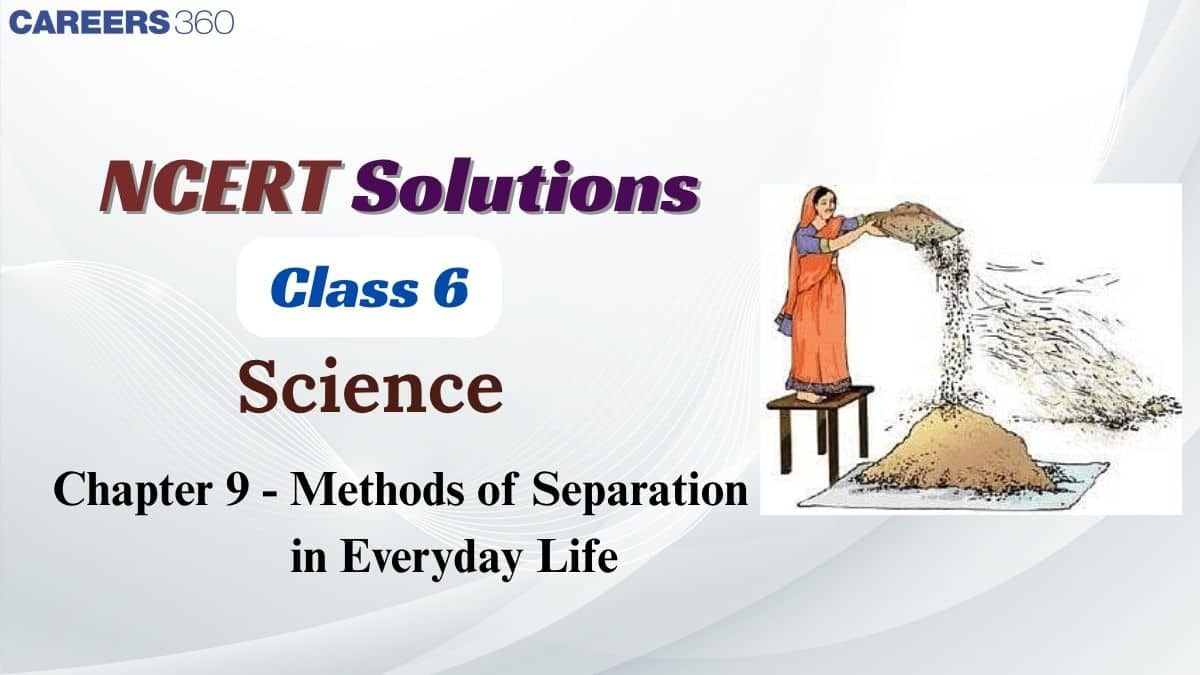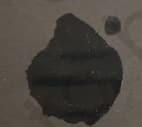It is a set of step-by-step answers that explain why and how substances are separated, covering methods like handpicking, winnowing, sieving, filtration, and evaporation with simple examples.
NCERT Solutions for Class 6 Science Chapter 9 - Methods of Separation in Everyday Life
Ever noticed elders separating tiny stones or unwanted substances from wheat or rice, tea leaves from tea? In our daily life, we come across mixtures of various substances, and separation becomes essential to remove unwanted substances from useful substances. Various techniques are used to separate these substances and in class 6 science chapter 9 methods of separation in everyday life solutions, students are going to discuss some separation techniques in detail.
This Story also Contains
- NCERT Solutions for Class 6 Science Chapter 9: Download PDF
- NCERT Solutions for Class 6 Science Chapter 9 (Exercise Questions with Answers)
- NCERT Solutions for Class 6 Science Chapter 9 ( Activities)
- Practice Questions for Class 6 Science Chapter 9
- Approach to Solve the Question of Class 6 Science Chapter 9
- Topics Covered in the NCERT Class 6 Science Chapter 9
- NCERT Solutions of Class 6 Science Chapter 9 Summary
- What You Will Learn from Class 6 Science Chapter 9 Methods of Separation in Everyday Life
- NCERT Solutions for Class 6 Science Chapter-Wise

The NCERT Solution for Class 6 Science is all about different methods of separating impurities from useful substances. These methods of separation in everyday life ncert solutions offer a systematic approach for understanding concepts through a series of solved questions. These NCERT solutions are aligned with the latest CBSE curriculum. Practice questions and approaches to solve questions are also included in this article.
NCERT Solutions for Class 6 Science Chapter 9: Download PDF
Students can download the NCERT Solutions for Class 6 Science Chapter 9 Methods of Separation in Everyday Life in PDF format for free. These NCERT Solutions for Class 6 are designed to help students understand the fundamental concepts and solve textbook questions with ease.
NCERT Solutions for Class 6 Science Chapter 9 (Exercise Questions with Answers)
Given below class 6 science chapter 9 methods of separation in everyday life question answer. These solutions explain how different methods like filtration, evaporation, and handpicking are used in daily life. They make it easier for students to relate scientific concepts to real-world applications.
Question 1. What purpose does handpicking serve in the process of separation?
(i) Filtration
(ii) Sorting
(iii) Evaporation
(iv) Decantation
Answer:
(ii). Sorting is the correct answer
Handpicking is used to sort or remove unwanted substances.
Question 2. Which of the following substances are commonly separated using the churning method?
(i) Oil from water
(ii) Sand from water
(iii) Cream from milk
(iv) Oxygen from air
Answer:
(iii). Cream from milk is the correct answer
Because when milk is churned, the lighter cream is separated from the milk
Question 3. Which factor is usually essential for the filtration?
(i) Apparatus size
(ii) Presence of air
(iii) Pore size
(iv) Temperature of the mixture
Answer:
(iii). Pore size is the correct answer
Because Filtration is used to separate solids from liquid using a filter, and pore size of the filter paper is the most important factor
Question 4. State with reason(s) whether the following statements are True [T] or False [F]. Also, correct the False statement(s).
(i) Salt can be separated from salt solution by keeping it in the Sun.
(ii) Handpicking should be used only when the quantity of one component is less.
(iii) A mixture of puffed rice and rice grains can be separated by threshing.
(iv) A mixture of mustard oil and lemon water can be separated by decantation.
(v) Sieving is used to separate a mixture of rice flour and water.
Answer:
(i). True
Reason: Salt will be left behind after the evaporation of water
Answer:
(ii). True
Reason: When impurities are less in quantity and can be easily identified, then only handpicking is used
Answer:
(iii). False
Reason: Threshing is used to separate the harvested stalk from the grain. Not to separate the two types of grains.
Correct statement: A mixture of puffed rice and rice grains can be separated by winnowing.
Answer:
(iv). True
Reason: Mustard oil and lemon water do not mix, so they can be separated by decantation
Answer:
(v). False
Reason: Because sieving is used to separate solids of different kinds
Correct statement: Filtration is used to separate a mixture of rice flour and water
Question 5. Match the mixtures in Column I with their method of separation in Column II.
|
Column I |
Column II |
|
(i). Gram flour mixed with black gram |
(a). Handpicking |
|
(ii). Chalk powder mixed with water |
(b). Magnetic separation |
|
(iii). Corn mixed with potatoes |
( c). Decantation |
|
(iv). Iron powder mixed with sawdust |
(d). Sieving |
|
(v). Oil mixed with water |
(e). Filtration |
Answer:
(i) - (d)
(ii) - (e)
(iii) - (a)
(iv) - (b)
(v) - ( c)
Question 6. In what situations would you use decantation instead of filtration to separate solids from liquids?
Answer:
Decantation is used to separate impurities from liquid, meaning that when impurities are heavy in solution then after some time these heavy impurities settle down, leaving pure liquid, and that liquid can be easily separated. Example sand settled down at the bottom of a glass of water.
Question 7. Can you relate the presence of nasal hair to any separation process?
Answer:
Nasal hairs are like a natural filter that prevents dust particles or other impurities from entering into our body through the nose. This process is similar to the filtration method, in which filter paper separates solid from liquid.
Question 8. During the COVID-19 pandemic, all of us wore masks. Generally, what material are they made of? What is the role of these masks?
Answer:
Masks are made up of non-woven fabrics, cotton and polyester. Masks act as protective shields that filter air, pollen and germs entering our bodies. The role of these masks is to filter air particles, pollens, etc.
Question 9. A mixture containing potatoes, salt and sawdust has been given to you. Outline a stepwise procedure for separating each component from this mixture.
Answer:
The following steps are given to separate potatoes, salt, and saws and :
- 1) Handpicking of potatoes
- 2) To dissolve salt, we have to add water, as salt is soluble in water, and sawdust is not
- 3) Filter the solution to separate the sawdust from the solution
- 4) To obtain salt, evaporate water
Question 10. Read the following story titled ‘Intelligent Leela’ and tick the most appropriate options. Provide a suitable title of your choice for the paragraph.
Leela was working on the farm with her father when she realised that they had left their drinking water at home. Before her father felt thirsty/hungry, she went to the nearby pond to fetch some water/grains. After obtaining some water in the container, she noticed that the water was muddy and fit/unfit for drinking. To purify the water, she kept it for some time, and then she filtered/ churned the muddy water using a piece of paper/muslin cloth. Leela, then, cooled/boiled the water for about 10 minutes in a covered pan. After cooling/boiling, she filtered/churned it again and made it fit/unfit for drinking. She served this water to her father while having food, who blessed her and appreciated her efforts
Answer:
- Thirsty
- Water
- Unfit
- Filtered
- Muslin cloth
- Boiled
- Cooling
- Filtered
- Fit
NCERT Solutions for Class 6 Science Chapter 9 ( Activities)
Given below are the activities covered in class 6 science chapter 9 methods of separation in everyday life solutions provide a perfect blend of conceptual and practical knowledge.
Activity 9.1 Page Number -165
Question 1. Take a handful of roasted peanuts and rub them between your palms. What happens?
Answer:
When we rub roasted peanuts between your palms, the skin of the peanuts comes off.
Question 2. Is it possible to separate the removed skin and the peanuts?
Answer:
Yes, it is possible to separate the removed skin and the peanuts.
Question 3. Now, try blowing it. What do you observe?
Answer:
When we blow air, the lighter peanut skins are blown away while the heavier peanuts remain. This shows that blowing air can separate heavier and lighter components of a mixture.
Question 4. Which of these components removed peanut skins or are peanuts blown away?
Answer:
The removed peanut skins are blown away because they are lighter than the peanuts.
Question 5. How do you think farmers separate so many grains from husk?
Answer:
Farmers traditionally use a bamboo tray to separate heavier and lighter components like grains from husk by winnowing, which uses the wind or air movement to separate them.
Activity 9.2 Page Number 168
Take a bowl or any container and fill it half with water Curiosity.
Add 2–3 teaspoons of salt into it and stir till the salt dissolves to form a solution.
Take a small piece of black or dark coloured thick paper and spread a few drops of the salt solution on it (Fig. 9.7a).
You can also create any art of your choice with this salt solution. Allow it to dry and then observe it (Fig. 9.7b and Fig. 9.7c)

(a) Before drying

(b) After drying

(c) Art created
Fig. 9.7: A few drops of salt solution spread on thick black paper
Question1. Do you observe some patches on the paper?
Answer:
Yes, we observe white patches or marks on the paper where the salt solution was applied.
Question 2. What do you think is left on the paper?
Answer:
The white patches on the paper are salt crystals. When the water evaporated, the dissolved salt was left behind.
Question 3. You can feel the presence of salt by touching the paper. Where has the water disappeared?
Answer:
The water has evaporated into the air. Only the salt, which does not evaporate, is left on the paper.
Activity 9.3 Page - 169
Take some salt solution (prepared in Activity 9.2) in a china dish.
If a china dish is not available, another suitable vessel may be used.
Heat and let the water boil away as shown in Fig. 9.8. Allow the china dish to cool down.

Fig. 9.8: Heating of china dish containing salt solution
Question 1. What do you observe? What is left in the china dish?
Answer:
After heating, the water in the salt solution boils away, and white salt crystals are left behind in the china dish.
Question 2. Did you get the salt back? You can feel the presence of salt in the china dish by touching the salt with your fingers.
Answer:
Yes, we got the salt back. The salt can be seen and felt as white crystals in the dish after the water evaporates.
Activity 9.4 Page- 171
Try to fold the filter paper yourself and make a cone as shown in Fig. 9.10.

Fig. 9.10: Folding a filter paper to form a cone
Place it inside a funnel kept on a conical flask and pour muddy water into it (Fig. 9.11)

Fig. 9.11: Filtration
Question 1. What do you observe?
Answer:
The muddy water slowly passes through the filter paper, and clear water collects in the conical flask. The mud particles remain on the filter paper.
Question 2. Do the mud particles pass through the filter paper?
Answer:
No, the mud particles do not pass through the filter paper. They get trapped on the paper, while only the clean water passes through.
Activity 9.6 Page -175
Write the following phrases on small slips of paper
1. Separating small stones from pulses.
2. Churning curd to obtain butter.
3. Taking out green chillies from cooked dalia (dish made of broken wheat) or poha (dish made of flattened rice).
4. Taking out seeds from watermelon.
5. Sorting piles of sawdust and iron nails from a mixed heap of building material.
6. Picking marigold flowers from a heap of other flowers to make a garland.
7. Separating pebbles from sand.
8. Separating coconut pieces from rice flour.
9. Separating oil from water.
10. Separating salt from salt solution
Now, take two baskets, each representing one of the two purposes for which we separate substances. Form two teams and see who will get the maximum correct entries.

Answer:
Below are two baskets representing two different purposes of separating substances.
| To remove any one of the components that is not useful | To separate two different but useful components |
| Separating small stones from pulses | Churning curd to obtain butter |
| Taking out green chillies from dalia or poha | Picking marigold flowers to make a garland |
| Taking out seeds from watermelon | Separating coconut pieces from rice flour |
| Sorting sawdust and iron nails from a mixed heap | Separating oil from water |
| Separating pebbles from sand | Separating salt from salt solution |
Note: Activity 9.5 Page- 172 involves designing and creating a working model of a water filter using low-cost materials. As it is a hands-on activity, it cannot be answered here.
Practice Questions for Class 6 Science Chapter 9
Some important practice questions related to the methods of separation in everyday life ncert solutions are given below. Students can download these solutions of NCERT from the download icon given above. These solutions explain how different methods like filtration, evaporation, and handpicking are used in daily life.
Question 1: Which method would you use to separate sand from water? Explain.
Answer:
Filtration is used to separate sand from water. A filter paper is placed in a funnel, and the mixture is poured through it. The sand stays on the filter paper as residue, and clear water passes through as filtrate.
Question 2: How is winnowing used in daily life?
Answer:
Winnowing is used to separate lighter husk particles from heavier grains like wheat or rice. The mixture is dropped from a height in the air. The wind blows the lighter husk away while the heavier grains fall straight down.
Question 3: Name a method used to separate salt from seawater. Why does it work?
Answer:
Evaporation is used to separate salt from seawater. Water evaporates when heated or left in the sun, leaving the salt behind because salt does not evaporate.
Question 4: What method would you use to separate iron nails from a mixture of sand and iron nails?
Answer:
Magnetic separation is used. A magnet is moved over the mixture. The iron nails stick to the magnet and get separated from the sand.
Question 5: Explain decantation with an example.
Answer:
Decantation is the process of pouring out clear liquid from a container without disturbing the sediment. For example, when muddy water is left undisturbed, the mud settles at the bottom, and the clean water on top can be poured off.
Approach to Solve the Question of Class 6 Science Chapter 9
The NCERT Solutions for Class 6 Science Chapter 9 Methods of Separation in Everyday Life helps students understand how simple techniques can separate different components of mixtures, and how it is useful in daily chores. We can follow the steps given below to solve questions from this chapter:
1. Before studying anything it is very important to understand the purpose behind it. So start by understanding why we need to separate substances, like removing impurities or collecting useful components? What type of impurities are present, and how is it different from the useful material? After that study methods such as handpicking, threshing, winnowing, sieving, sedimentation, decantation, filtration, and evaporation.
2. Students must relate class 6 science chapter 9 methods of separation in everyday life solutions to their daily activities. For example use of winnowing to separate husk from grain, Sieving flour to remove bran and Evaporating salt water to obtain salt.
3. While solving questions it is important to remember that simple separation task may require combination of methods. For example, to purify muddy water multiple methods, like sedimentation, followed by decantation, then filtration are used.
4). Practice different types of questions from methods of separation in everyday life class 6 question answer that helps you to develop a proper understanding of the concepts provided in the textbook. These solutions will help you in practicing the questions effectively.
5). Identify your weaknesses in class 6 science chapter 9 methods of separation in everyday life question answer and focus on those parts. Regular practice and revision of these solutions will help you turn weaknesses into strengths.
Topics Covered in the NCERT Class 6 Science Chapter 9
All the topics and subtopics covered in the NCERT Solutions for Class 6 Science Chapter 9 Methods of Separation in Everyday Life are given below. A basic understanding of these topics helps students to solve complex problems easily.
- Need for separation
- Methods of Separation
- Common Separation Techniques
- Soluble and Insoluble Substances
- Application in Daily Life
Also check the links to access NCERT Books and syllabus given below:
NCERT Solutions of Class 6 Science Chapter 9 Summary
The class 6 science chapter 9 methods of separation in everyday life solutions are all about the methods used to separate different substances. It teaches us about how to separate unwanted substances from mixtures to make them usable using different techniques like handpicking, winnowing, filtration, decantation, sieving, evaporation, and the use of magnets. All these techniques are not only used in the kitchen or classroom, but they also form the basis of higher classes, like metallurgy in higher classes.
What You Will Learn from Class 6 Science Chapter 9 Methods of Separation in Everyday Life
In this chapter students will learn about the different methods used to separate mixtures into their components based on physical properties. Some things that students will learn by using the methods of separation in everyday life class 6 question answer are given below:
-
Here students will learn about mixtures and pure substances and the difference between them.
-
This chapter helps students understand why it is important to separate substances.
-
Different methods of separation like Handpicking, Threshing, Sieving, Sedimentation and Decantation, Filtration, Evaporation and Condensation are explained well in these class 6 science methods of separation in everyday life question answers.
-
Here students will learn how these separation methods are used in homes and industries like separating rice and stones, purifying water, or making salt from seawater.
-
These class 6 science chapter 9 methods of separation in everyday life question answers help students learn how more than one method may be used together for separation, such as in purification of muddy water.
NCERT Solutions for Class 6 Science Chapter-Wise
Besides NCERT Solutions for Class 6 Science Chapter 9 Methods of Separation in Everyday Life, chapter-wise solutions are given below:
Frequently Asked Questions (FAQs)
Chapter 9 focuses on the various methods of separation that we commonly use in everyday life. NCERT Class 6 Science Chapter 9 explains how these methods help in separating different substances from mixtures based on their physical properties.
Separation of substances is essential because it allows us to obtain pure materials, enhances the quality of food, and helps in recycling processes. Students can refer Methods of separation in everyday life Class 6 PDF for detailed solutions on questions related to the separation of substances.
Methods of separation discussed in this chapter are handpicking, sieving, filtration, evaporation, and distillation.
Filtration is a method used to separate solid particles from liquids or gases using a filter. The filter allows the liquid to pass through while trapping the solid particles.
This chapter is important because it teaches how to separate useful substances from impurities using simple methods like winnowing, sieving, and filtration. It helps students connect science with daily life and understand the practical use of these techniques in households and industries.
The class 6 science methods of separation in everyday life question answer is important because it helps us understand how different substances in a mixture can be separated using simple and practical techniques. These methods, such as filtration, evaporation, and winnowing, are not only used in science but also in our daily lives.
Courses After 12th
Applications for Admissions are open.
As per latest syllabus. Physics formulas, equations, & laws of class 11 & 12th chapters
JEE Main Important Chemistry formulas
Get nowAs per latest syllabus. Chemistry formulas, equations, & laws of class 11 & 12th chapters
JEE Main high scoring chapters and topics
Get nowAs per latest 2024 syllabus. Study 40% syllabus and score upto 100% marks in JEE
JEE Main Important Mathematics Formulas
Get nowAs per latest syllabus. Maths formulas, equations, & theorems of class 11 & 12th chapters
